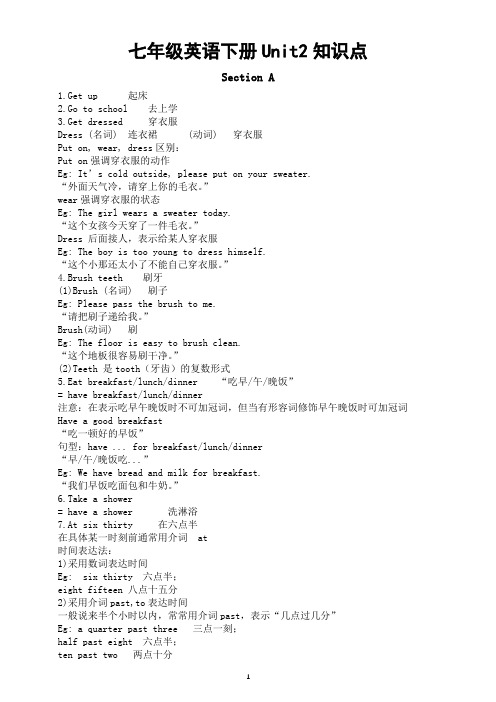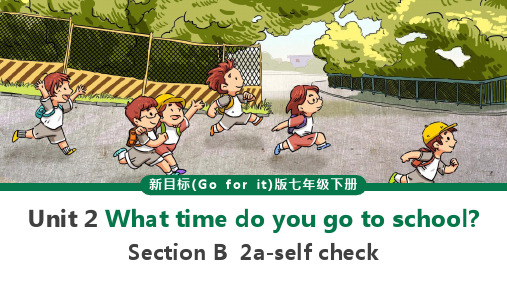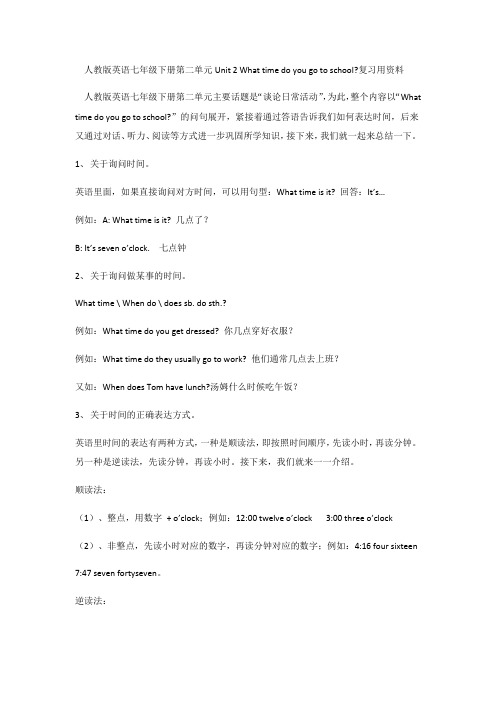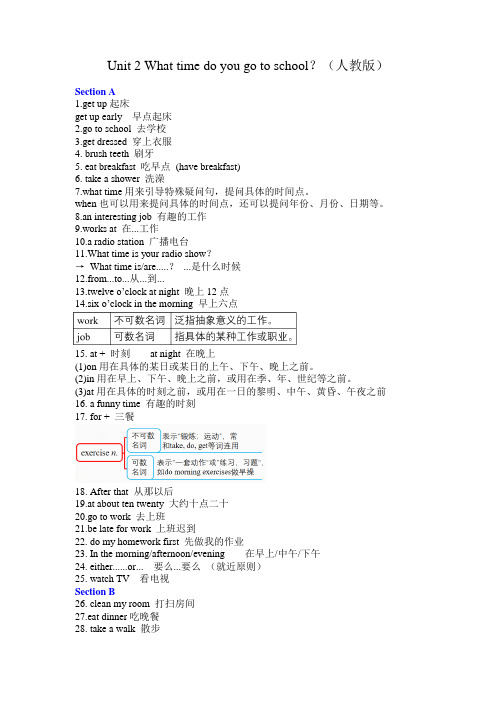初中英语人教版七年级下册What time do you go to school
人教版七下 Unit 2 What time do you go to school?知识点总结

Unit 2 What time do you go to school?必背短语get up 起床 get home到达家中 get to work到达工作岗位 make breakfast做早饭make a shower schedule做一个洗澡的安排 practice guitar 练吉它 leave home 离家take a shower = have a shower 洗淋浴澡 take the Number 17 bus to the Hotel 乘17路公共汽车去旅馆go to class 上课 go to school 上学 go to work 上班(反义词 go home)have breakfast/dinner/lunch吃早晚午饭put on 穿衣服(反义词take off) do one’s homework 做家庭作业tell sb. about sth. 告诉某人某事 tell sb. to do sth. / tell sb. sth.know about sth. 知道某方面的情况 love to do/doing = like to do/doing 喜欢干某事listen to the early morning news on radio 听电台早间新闻 listen to 听…watch the early morning news on TV 看电视早间新闻around six o’clock 六点左右 in the morning 在早上 in the afternoon 在下午 in the evening 在晚上考点解析※get up 起床 eat breakfast=have breakfast 早餐(三餐前省略冠词)have三餐吃…..※job与 work job与 work 都是指工作,但job是可数名词,work是不可数名词. a job 一份工作 work 可以做动词讲,但是job不可以※Life 生活 lives (复数) health健康 healthy健康的 healthily健康地unhealthy 不健康的 keep health 保持健康 healthy food 健康食品have a healthy life =live a healthy life 过着健康的生活※3个穿的区别:wear 表状态,接服装、手套、眼镜、香水等 put on 表动作,接服装dress 表动作,接sb/ oneself get dressed穿衣语法精讲1,问时间what time或者when what time询问具体时间(几点几分) when:时间、日期、年份、月份等提问2,take a shower=have a shower 沐浴3,at a radio station 在广播电台 from……to ……从……到…..(连接两个时间或地点)4,be/ arrive late for :迟到 be late for school5,exercise 锻炼,练习(动、不可数名词) do/take exercise 做锻炼(运动)6,频度副词(实意动词前;be动词后)Always usually often sometimes seldom hardly never★下面的排列更直观地说明了这几个词的频率的"大小"。
初中英语人教版七年级下Unit 2 What time do you go to school知识点

七年级英语下册Unit2知识点Section A1.Get up 起床2.Go to school 去上学3.Get dressed 穿衣服Dress (名词) 连衣裙 (动词) 穿衣服Put on, wear, dress区别:Put on强调穿衣服的动作Eg: It’s cold outside, please put on your sweater.“外面天气冷,请穿上你的毛衣。
”wear强调穿衣服的状态Eg: The girl wears a sweater today.“这个女孩今天穿了一件毛衣。
”Dress 后面接人,表示给某人穿衣服Eg: The boy is too young to dress himself.“这个小那还太小了不能自己穿衣服。
”4.Brush teeth 刷牙(1)Brush (名词) 刷子Eg: Please pass the brush to me.“请把刷子递给我。
”Brush(动词) 刷Eg: The floor is easy to brush clean.“这个地板很容易刷干净。
”(2)Teeth 是tooth(牙齿)的复数形式5.Eat breakfast/lunch/dinner “吃早/午/晚饭”= have breakfast/lunch/dinner注意:在表示吃早午晚饭时不可加冠词,但当有形容词修饰早午晚饭时可加冠词Have a good breakfast“吃一顿好的早饭”句型:have ... for breakfast/lunch/dinner“早/午/晚饭吃...”Eg: We have bread and milk for breakfast.“我们早饭吃面包和牛奶。
”6.Take a shower= have a shower 洗淋浴7.At six thirty 在六点半在具体某一时刻前通常用介词 at时间表达法:1)采用数词表达时间Eg: six thirty 六点半;eight fifteen 八点十五分2)采用介词past,to表达时间一般说来半个小时以内,常常用介词past,表示“几点过几分”Eg: a quarter past three 三点一刻;half past eight 六点半;ten past two 两点十分半小时过后多用介词to,表示“差几分到几点”Eg: a quarter to three 两点四十五;twenty to four 三点四十3)a. m. 和p. m.A.m. 表示“午前;上午”(午夜12:00后至中午12:00前);p.m. 表示“午后;下午”(中午12:00后至午夜12:00前)。
人教版七年级英语下册《Unit 2 What time do you go to school》(含

《Unit 2 What time do you go to school》(含5课时)导学案【学习目标】1. 正确听、说、读、写section A 单词。
2. 运用“what time”和“where”引导的特殊疑问句询问并回答日常活动的时间。
【学习重点】熟练运用“what time”和“where”引导的特殊疑问句。
【学习难点】准确使用“what time”和“where”引导的特殊疑问句询问并回答。
【学习流程】一、自主学习(教师寄语:Knowledge is power.知识就是力量.)学习任务一:会读写、本课4个单词及7个短语.1、个人自读、记忆本课单词.2、小组互相检查单词读的情况.3、小组内竞赛,看谁记得快、准,并展示(默写)单词: 锻炼;练习___________ 淋浴,淋浴器___________通常___________ 刷;刷净___________短语:几点,什么时候_________________ 穿上衣服_________________ 洗淋浴_________________ 吃早饭_________________广播电台_________________ 刷牙_________________4、认真观察1a的图画,将词语与图片搭配,并核对答案。
二、交流展示学习任务二:运用句型What time ...?谈论Rick的日常生活.1、熟读1a中的对话,理解并复述.2、小组为单位,两人合作,谈论Rick的日常生活(分别扮演Rick和采访者).3、熟读2d中的对话,理解并复述.4、小组为单位,两人合作,角色扮演Scott和采访者.【合作共建】小组讨论该如何表达时间?写出下列时间.9:00 ________________ 11:00 ____________10:30 _______________ 12:50 ____________三、知识反馈(一)根据汉语完成句子1. 我早上六点起床.I ______ ______ _______ six in the morning.2.他的爸爸晚上九点洗澡.His father ______ ______ _______ ____ nine in the evening.3.你每天早上七点跑步吗?_____ you _______ ______ seven every morning?4.你姐姐几点吃晚饭?______ ______ _____ your sister eat _______?5.我上班从不迟到.I’m_______ _____ ______ work.6.他十二点吃午饭.He ______ _____ at twelve.(二)句型转换,按要求改写句子.1.Alice takes a shower at 9:00.(提问划线部分)__________________________________________?2.I have some tea in my cup.(改为否定句)__________________________________________.3.The old man is seventy.( 提问划线部分)__________________________________________.四、学后反思____________________________________________专注:心无旁骛,万事可破Unit 2 What time do you go to school?第2课时【学习目标】1.熟练掌握本课的单词和部分短语.2.熟练运用句型询问时间,以及在某个时间干什么事What's the time? It's…What time do you usually…? I usually…at…3.能根据要求写出简单的句子表述自己和他人的日常活动.【学习重点】能根据要求写出简单的句子表述自己和他人的日常活动.【学习难点】一般现在时中不同人称对应的动词的变化形式.【学习流程】一、自主学习(教师寄语:Knowledge is power.知识就是力量.)学习任务一: 读写、记忆本课单词和短语.1.个人自读,记忆.2.小组互相检查读、写情况.3.根据汉语写出下列英语单词和短语并展示.单词:最好的_________ 小时_________ 组;群________ 牙齿__________ 短语:在周末_______________ 去上班_______________二、交流展示学习任务二: 通过练习描述一天的时间1. Grammar Focus2. Writing(3a,3b)3. Survey (3c)学习任务三:试着模仿说出自己的一天的活动三、知识反馈专注:心无旁骛,万事可破(一)单项选择1. The bus usually ________ him to work.A. takeB. takesC. /D. bring2. I usually go to school _________ seven o'clock..A. atB. inC. onD. for3. — What's the time? —__________ nine-fifteen.A. The time isB. It'sC. AtD. This is4.We go to ________at six thirty in the morningA. the schoolB. a schoolC. schoolD. schools(二)用括号内所给词的适当形式填空1.Alice brushes her __________(tooth) every morning.2.I t’s __________(fun) to play volleyball on the beach(沙滩).3.I usually get __________ (dress) at six in the morning.4.Tom is my __________ (good) friend in my class.5.My father __________ (work) in a school.四、学后反思____________________________________________专注:心无旁骛,万事可破Unit 2 What time do you go to school?第3课时【学习目标】1.正确听、说、读、写section B单词.2.能够利用所学句型询问及表述时间.3. 学会谈论自己或别人的日常生活,询问及表述时间.【学习重点】学会谈论自己或别人的日常生活,询问及表述时间。
What+time+do+you+go+to+school+知识点及练习 人教版七年级英语下册

Unit 2 What time do you go to school?◆短语归纳1. what time 几点2. go to school 去上学3. get up 起床4. take a shower 洗淋浴5. brush teeth 刷牙6. get to 到达7. do homework 做家庭作业8. go to work 去上班9.go home 回家10. eat breakfast 吃早饭11. get dressed 穿上衣服12. get home 到家13. either…or… 要么…要么… 14. go to bed 上床睡觉15. in the morning/ afternoon/ evening 在上午/下午/晚上16. take a walk 散步17. lots of=a lot of 许多,大量18. radio station 广播电台19. at night 在晚上20. be late for=arrive late for 迟到1. at + 具体时间点在几点(几分)2. eat breakfast/ lunch/dinner 吃早饭/午饭/晚饭3. thirty\half past +基数词……点半4. fifteen\a quarter to +基数词差一刻到……点5. take a/an +名词从事……活动6. from …to … 从……到……7. need to do sth 需要做某事My School DayI am a student. I usually get up at seven, and I eat breakfast at seven thirty. Then I go to school at eight. School starts at eight thirty. I eat lunch at twelve. I go home at 17:00. I often eat dinner at 19:00 and then play the piano. I do my homework at 20:00. At 22:00, I go to bed.1.What time do you usually _____ _____?你通常几点起床?2.I usually get up _____ six thirty.我通常六点半起床。
初中英语人教版七年级下册《Unit 2 What time do you go to school

( )3. Liangliang loves his school because his father is a teacher there.
T
( )4. People in this village want to have a bridge.
presentation 2c.Read the passage again. Complete the sentences with the words from the passage.
dream come _____?
presentationLanguage points
1.One 11-year-old boy, Liangliang,一个十一岁的男孩,亮亮。 11-year-old boy中11-year-old是一个复合形容词,作定语, 修饰名词boy,意为“11岁的”。 由“数词-名词-(形容词)” 构成的复合形容词中,名词只能用单数。 e.g. a two-month holiday两个星期的假期。
转盘指到哪里,学生用哪 个单词造句。
let's play
presentation 2a: look at the picture and title below, guess what the passage is about?
It is about that the students cross the river to school by ropeway.
One 11-year-old boy, Liangliang, crosses the river every school day. But he is not afraid. “ I love to play with my classmates. And I love my teacher. He’s like a father to me.”
人教版七年级英语下复习Unit2 What time do you go to schoo

(2013·山东潍坊)When did the terrible earthquake happen in Sichuan? It happened_____8:02____the morning of April 20th,2013.
A.on;in B.at;on C.at;in D.on;on
go home 回家 letter n.信
around adv.大约
start v.开始;出发 write v.书写;写
tell v.告诉;讲述 me pron.我(I的宾格)
soon adv.不久
wish n.希望;祝愿
best (good,well最高级)最好的(地)
Saturday n.星期六 am (a.m.)上午 survey n.调查;考察
o’clock adv.(只用于正点)......点钟 work v.&n. 工作
hour n.小时 brush v.刷
teeth n.(tooth复数)牙齿
after 在......之后 go to work 去上班
get to 到达
bus n.公共汽车 hotel n.旅馆
all prep.全部;全体
in May in summer in 2011
介词on用在日期、星期几、节日前,也可表示具体
某一天的早上、下午、晚上等。
usually 频率副词 usually: 频度副词,意为“通常”。
在句中作状语,一般位于实义动词之前, 系动词、助动词或情态动词之后。
Eg: I usually have lunch at school.
逆读法: 借助介词past或to 。 小于等于30分钟:分钟+past+小时 几点过几分
初中英语人教版七年级下册《Unit2 What time do you go to school S

Task 5Role-play the conversation. Scott has an interesting job. He works at a radio station. Scott, what time is your radio show?
From twelve
o’clock at night to
six o’clock in the
morning.
…
…
Task 6Reading
2d 勾画出红色短语,两人一组尝试翻译短语
Interviewer: Scott has an interesting job. He works at a radio station. Scott, what time is your radio show?
想一想: 60 __s_i_x_t__ 70 __s_e_v_e_n__t_y
80 e_yi_g__h_t__ 90n_i_n_e__t____
y
y
Language points
2. always 意为“总是,一直” usually 意为“通常地,一直地” 频率副词 never 意为“从未,绝不”
新目标(Go for it)版七年级下册
Unit 2 What time do you go to school?
Section A 2a-2d
学习目标
1.识记never, early, job, work, radio station, at night, go to work, be late for等辞汇及短语;
Unit2Whattimedoyougotoschool复习资料人教版七年级英语下册

人教版英语七年级下册第二单元Unit 2 What time do you go to school?复习用资料人教版英语七年级下册第二单元主要话题是“谈论日常活动”,为此,整个内容以“What time do you go to school?”的问句展开,紧接着通过答语告诉我们如何表达时间,后来又通过对话、听力、阅读等方式进一步巩固所学知识,接下来,我们就一起来总结一下。
1、关于询问时间。
英语里面,如果直接询问对方时间,可以用句型:What time is it? 回答:It’s…例如:A: What time is it? 几点了?B: It’s seven o’clock. 七点钟2、关于询问做某事的时间。
What time \ When do \ does sb. do sth.?例如:What time do you get dressed? 你几点穿好衣服?例如:What time do they usually go to work? 他们通常几点去上班?又如:When does Tom have lunch?汤姆什么时候吃午饭?3、关于时间的正确表达方式。
英语里时间的表达有两种方式,一种是顺读法,即按照时间顺序,先读小时,再读分钟。
另一种是逆读法,先读分钟,再读小时。
接下来,我们就来一一介绍。
顺读法:(1)、整点,用数字+ o’clock;例如:12:00 twelve o’clock 3:00 three o’clock (2)、非整点,先读小时对应的数字,再读分钟对应的数字;例如:4:16 four sixteen 7:47 seven fortyseven。
逆读法:(1)、当分钟数小于30时,用“分钟对应的数字+ past + 小时对应的数字”,例如:8:12 twelve past eight 9:28 twentyeight past nine 10:08 eight past ten特殊情况:当分钟数等于15时,15可以用英语单词“a quarter来表示”,例如:6:15 a quarter past six;又如:9:30half past nine。
What time do you go to school?知识点复习-人教版七年级英语下册

Unit 2 What time do you go to school?(人教版)Section A1.get up起床get up early 早点起床2.go to school 去学校3.get dressed 穿上衣服4. brush teeth 刷牙5. eat breakfast 吃早点(have breakfast)6. take a shower 洗澡7.what time用来引导特殊疑问句,提问具体的时间点。
when也可以用来提问具体的时间点,还可以提问年份、月份、日期等。
8.an interesting job 有趣的工作9.works at 在...工作10.a radio station 广播电台11.What time is your radio show?→What time is/are.....?...是什么时候12.from...to...从...到...13.twelve o’clock at night 晚上12点14.six o’clock in the morning 早上六点15. at + 时刻at night 在晚上(1)on用在具体的某日或某日的上午、下午、晚上之前。
(2)in用在早上、下午、晚上之前,或用在季、年、世纪等之前。
(3)at用在具体的时刻之前,或用在一日的黎明、中午、黄昏、午夜之前16. a funny time 有趣的时刻17. for + 三餐18. After that 从那以后19.at about ten twenty 大约十点二十20.go to work 去上班21.be late for work 上班迟到22. do my homework first 先做我的作业23. In the morning/afternoon/evening 在早上/中午/下午24. either......or... 要么...要么(就近原则)25. watch TV 看电视Section B26. clean my room 打扫房间27.eat dinner吃晚餐28. take a walk 散步26. I don’t have much time for breakfast 我没有足够的时间吃早点27. eat very quickly 吃得非常快28. play computer games 玩电脑游戏29. After school 放学后30. play basketball 打篮球31. go to bed 睡觉32. For + 一段时间33. get home 回家go home 回家时间的表达所有的时间都可以用“小时+ 分钟”直接读:6:10 six ten如果所表述的时间在半小时之内,可以用“分钟+ past + 小时”:6:10 ten past six如果所表述的时间在半小时之外,可以用“(相差的)分钟+ to + (下一)小时”:10:35 twenty-five to eleven如果所表述的时间恰好为半小时,可以用“half + past + 小时”:11:30 half past eleven如果所表述的分钟和15有关,就有三种表达法:(15分钟又叫一刻钟:a quarter)9:15- nine fifteen ;fifteen past nine ;a quarter past nine。
- 1、下载文档前请自行甄别文档内容的完整性,平台不提供额外的编辑、内容补充、找答案等附加服务。
- 2、"仅部分预览"的文档,不可在线预览部分如存在完整性等问题,可反馈申请退款(可完整预览的文档不适用该条件!)。
- 3、如文档侵犯您的权益,请联系客服反馈,我们会尽快为您处理(人工客服工作时间:9:00-18:30)。
Unit 2What time do you go to school?
Period 5 Content Section B 3a, 3b, Self Check 1, 2
一、教学目标要求
1.能够按照时间顺序或习惯把一天活动安排恰当排序,如,I always get up early at six. Then Iquickly have a shower and eat breakfast. 等。
2.能够模仿3a写出自己的一日安排。
3.能够根据经验把动词和宾语搭配起来,如,brush, your teeth,组成brush your teeth等。
4.能够根据句意填入恰当的短语,完成整个句子。
5.能够认读并能工整书写所学单词和句子,如:life。
6.能根据所给关键词编造对话。
二、教学过程
Step1复习已学目标语言
1、 Look at the screen and answer my questions.
— When does the boy get up?
— When does the girl play volleyball? 2、仿照上述对话,组织Pair work复习活动
OK. Now let’s do pair work about your routines:
学生两人活动,教师抽查几组学生。
Step2 导入新课话题,
Well, we’re going to learn Section B.
教师板书或课件显示:
Unit 2 Period 5 What time do you go to school?
教师询问几个学生:
What time do you get up/exercise/go to bed? 3a
1、读前看图,猜测日常生活习惯
First, look at the picture. Is the boy healthy? (Yes)
Why? (he often exercises.)
Good, you are right.
2、学生朗读3a语句,消除学生的语言障碍。
Now let’s read 3a. If you don’t know the words or phrases, please ask me for help.
教师对学生陌生的内容及语言教学讲解、指导,确认消除学生的语言障碍。
Now, please number the sentences in order to make a story.
Ok, check your numbers.
找一两个学生说出自己的排序,如有错误,分析错误原因。
(提醒学生注意时间顺序,关注after / then)
3、按照正确顺序抄写语篇,为仿写做好准备。
Well, write down the sentences and we can get a passage. Then read it to yo ur partner.
4、朗读3a语篇后,仿写自己一天的活动安排。
First, let’s read 3a together. Then write about your own daily routine. We can these expressions: after that, then, so, but, it’s good for me, it’s not good for me.
学生进行仿写练习,教师巡视指导。
教师应当关注两点:
(1)学生语言的正确性;
(2)语篇的连贯性(学生能否正确运用连接词语)。
课堂点评及交流,收集学生优秀写作相互学习
Now, we have got so many great writings. Please show and share them. 根据刚才的巡视与指导,纠正错误,把优秀作品展示出来。
让学生向自己的同伴进行学习比教师演示、讲解书本范例要直接有效得多。
三、练习
1、Self check 1
阅读左右两部分,结对成5个短语
Please read the words and make phrases.
Check your answers. 根据句意,填入恰当的短语Now, please use the phrases to complete the sentences.
提醒学生,有的用动词原形,有的用第三人称单数,找出依据。
Let’s show your answers.
2、Self check 2完成练习,巩固本单元重点目标语言
Well, look at self check 2, there are 2 conversations.
Now, complete the conversations with questions and answers.
Use the words in the brackets to help you. Work in groups.
小组交流、修正。
四、分角色朗读,巩固复习
Now you are A and your partner is B. Read the conversations. Then you are B and your partner is A, read again.
五、拓展。
Now, let’s make a survey and fill in the chart:
What do you do after school?
What time do you do it?
OK, please write the survey. The beginning:
What activities do my classmates and I do after school?Here are the answer s.
1.展开同学间的“采访”活动,列表填出活动同学姓名(Name)、
课余活动内容(After-school Activities)和时间(Time);
2.用完整的英语句子写出表格所列的每一活动,完成“采访报
告”。
课外完成,教师收集存档。
如果课堂时间充裕,可以在课堂上展示优秀成果。
也可以学生课后开展并完成任务。
教师按规定时间收取任务成果(文本作业)。
择机在课堂上展示“优秀成果”。
六、小结。
What have we learned?
六、Homework(布置作业)
Write a passage about your daily life by yourself.。
